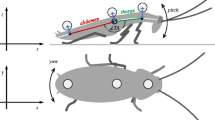Abstract
Despite impressive variation in leg number, length, position and type of skeleton, similarities of legged, pedestrian locomotion exist in energetics, gait, stride frequency and ground-reaction force. Analysis of data available in the literature showed that a bouncing, spring-mass, monopode model can approximate the energetics and dynamics of trotting, running, and hopping in animals as diverse as cockroaches, quail and kangaroos. From an animal's mechanical-energy fluctuation and ground-reaction force, we calculated the compression of a virtual monopode's leg and its stiffness. Comparison of dimensionless parameters revealed that locomotor dynamics depend on gait and leg number and not on body mass. Relative stiffness per leg was similar for all animals and appears to be a very conservative quantity in the design of legged locomotor systems. Differences in the general dynamics of gait are based largely on the number of legs acting simultaneously to determine the total stiffness of the system. Four- and six-legged trotters had a greater whole body stiffness than two-legged runners operating their systems at about the same relative speed. The greater whole body stiffness in trotters resulted in a smaller compression of the virtual leg and a higher natural frequency and stride frequency.
Similar content being viewed by others
References
Alexander R McN (1988) Elastic mechanisms in animal movement. Cambridge University Press, Cambridge, pp 116–125
Alexander R McN (1989) Optimization of gaits in the locomotion of vertebrates. Physiol Rev 69:1199–1227
Biewener AA, Taylor CR (1986) Bone strain: a determinant of gait and speed? J Exp Biol 123:383–400
Blickhan R (1989a) The spring-mass model for running and hopping. J Biomech 22:1217–1227
Blickhan R (1989b) Running and hopping. In: Wieser W, Gnaiger E (eds) Energy transformation in cells and animals. Thieme, Stuttgart, pp 183–189
Blickhan R, Full RJ (1987) Locomotion energetics of the ghost crab: II. Mechanics of the center of mass during walking and running. J Exp Biol 130:155–174
Blickhan R, Full RJ (1992) Mechanical work in terrestrial locomotion. In: Biewener A (ed) Biomechanics (Structures): A practical approach. Oxford University Press, Oxford, pp 75–96
Blickhan R, Full RJ, Ting LH (1993) Exoskeletal strain: evidence for a trot-gallop transition in rapid running ghost crabs. J Exp Biol 179:301–321
Cavagna GA (1975) Force platforms as ergometers. J Appl Physiol 39:174–179
Cavagna GA, Saibene FP, Margeria R (1964) Mechanical work in running. J Appl Physiol 19:249–256
Cavagna GA, Heglund NC, Taylor CR (1977) Mechanical work in terrestrial locomotion: two basic mechanisms for minimizing energy expenditure. Am J Physiol 233(5): R243-R261
Cavagna GA, Franzetti P, Heglund NC, Willems P (1988) The determinants of the step frequency in running, trotting and hopping in man and other vertebrates. J Physiol (Lond) 399:81–92
Farley CT, Blickhan R, Saito J, Taylor CR (1991) Stride frequency and the tuning of muscle-tendon springs. J Appl Physiol 71:2127–2132
Farley CT, Glasheen J, McMahon TA (1993) Running springs: Speed and animal size. J Exp Biol (in press)
Full RJ (1989) Mechanics and energetics of terrestrial locomotion: From bipeds to polypeds. In: Wieser W, Gnaiger E (eds) Energy transformation in cells and animals. Thieme, Stuttgart, pp 175–182
Full RJ (1991) Concepts of efficiency and economy in land locomotion. In: Blake RW (ed) Concepts of efficiency, economy and related concepts in comparative animal physiology. Cambridge University Press, New York, pp 97–131
Full RJ, Tu MS (1990) The mechanics of six-legged runners. J Exp Biol 148:129–146
Full RJ, Tu MS (1991) Mechanics of rapid running insects: two-,four-, and six-legged locomotion. J Exp Biol 156:215–231
Full RJ, Anderson BD, Finnerty CM, Feder ME (1988) Exercising with and without lungs. I. The effects of metabolic cost, maximal oxygen transport and body size on terrestrial locomotion in salamander species. J Exp Biol 138:471–485
Full RJ, Zuccarello DA, Tullis A (1990) Effect of variation in form on the cost of terrestrial locomotion. J Exp Biol 150:233–246
Full RJ, Blickhan R, Ting LH (1991) Leg design in hexapedal runners. J Exp Biol 158:369–390
Heglund NC, Taylor CR (1988) Speed, stride frequency and energy cost per stride: how do they change with body size and gait? J Exp Biol 138:301–318
Heglund NC, Taylor CR, McMahon TA (1974) Scaling stride frequency and gait to animal size: mice to horses. Science 186:1112–1113
Heglund NC, Cavagna GA, Taylor CR (1982) Energetics and mechanics of terrestrial locomotion. III. Energy changes of the center of mass as a function of speed and body size in birds and mammals. J Exp Biol 79:41–56
Hildebrand M (1976) Analysis of tetrapod gaits: general considerations and symmetrical gaits. In: Herman RM, Grillner S, Stein PSG, Stuart DG (eds) Neural control of locomotion. Plenum Press, New York, pp 203–236
John-Alder HB, Garland T, Bennett AF (1986) Locomotory capacities, oxygen consumption, and the cost of locomotion of the shingle-back lizard (Trachydosaurus rugosus). Physiol Zool 59(5): 523–531
McGeer T (1990) Passive bipedal running. Proc R Soc Lond B 240:107–134
McMahon TA (1985) The role of compliance in mammalian running gaits. J Exp Biol 115:263–282
McMahon TA (1990) Spring-like-properties of muscles and reflexes in running. In: Winters JM, Woo SL-Y (eds) Multiple muscle systems. Springer, New York, pp 578–590
McMahon TA, Cheng GC (1990) The mechanics of running: how does stifness couple with speed? J Biomech 23:65–78
McMahon TA, Valiant G, Frederick EC (1987) Groucho running. J Appl Physiol 62:2326–2337
Raibert MH, Chepponis M, Brown BJr (1986) Running on four legs as though they were one. IEEE J Rob Autom RA-2:70–82
Taylor CR, Schmidt-Nielsen K, Raab JL (1970) Scaling of energetic cost to body size in mammals. Am J Physiol 210:1104–1107
Ting L, Full RJ, Blickhan R, Tu MS (1990) Is static stability important in hexapedal runners? Am Zool 30:135A
Author information
Authors and Affiliations
Rights and permissions
About this article
Cite this article
Blickhan, R., Full, R.J. Similarity in multilegged locomotion: Bouncing like a monopode. J Comp Physiol A 173, 509–517 (1993). https://doi.org/10.1007/BF00197760
Accepted:
Issue Date:
DOI: https://doi.org/10.1007/BF00197760




